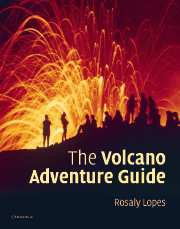Book contents
- Frontmatter
- Contents
- Preface
- Acknowledgments
- PART I Choosing a volcano to visit
- PART II Guides to volcanoes
- 6 Introduction to the field guides
- 7 Volcanoes in Hawaii
- 8 Volcanoes in the continental USA
- 9 Volcanoes in Italy
- 10 Volcanoes in Greece
- 11 Volcanoes in Iceland
- 12 Volcanoes in Costa Rica
- 13 Volcanoes in the West Indies
- Appendix I Useful information for preparing a volcano trip
- Appendix II Tours to volcanoes
- Bibliography
- Glossary
- Index
10 - Volcanoes in Greece
from PART II - Guides to volcanoes
Published online by Cambridge University Press: 01 September 2010
- Frontmatter
- Contents
- Preface
- Acknowledgments
- PART I Choosing a volcano to visit
- PART II Guides to volcanoes
- 6 Introduction to the field guides
- 7 Volcanoes in Hawaii
- 8 Volcanoes in the continental USA
- 9 Volcanoes in Italy
- 10 Volcanoes in Greece
- 11 Volcanoes in Iceland
- 12 Volcanoes in Costa Rica
- 13 Volcanoes in the West Indies
- Appendix I Useful information for preparing a volcano trip
- Appendix II Tours to volcanoes
- Bibliography
- Glossary
- Index
Summary
Greece
Greece is not a country known for active volcanoes, but it does have one of the world's most famous – the beautiful Santorini, in the Aegean Sea. Around 1600 BC, Santorini exploded with the energy equivalent to some 3,000 atoms bombs, in what was one of the most cataclysmic eruptions of all time. The Minoan eruption, as it is often called, had a tremendous impact on Greece and the Aegean, but just how much is a subject of considerable debate and tomes of research. Did the effects of the eruption cause the downfall of the Minoan civilization? Some refute this, but none doubt that the eruption changed Santorini forever. The original volcano, a stratocone, fragmented into the broken circle of small islands that we see today. Since then, several eruptions have occurred in these islands but all have been considerably less violent than the Minoan. At present the only activity is fumarolic, concentrated on the island of Nea Kameni – the “Young Burnt Island” in the center of the Santorini archipelago. Visitors are often surprised to find out that this island could erupt again anytime.
Greece has a few other volcanoes still considered active, on the islands of Methana, Milos, Nisyros, Yali, and Kos. Of these, only Methana and Nisyros have erupted during historic times. All activity has been mild in the last few hundred years, consisting of small explosive events. People don't come to Greece to see volcanoes in action, though the modest eruptions in recent times have been enjoyed by those lucky enough to be there at the right time.
- Type
- Chapter
- Information
- The Volcano Adventure Guide , pp. 224 - 238Publisher: Cambridge University PressPrint publication year: 2005

